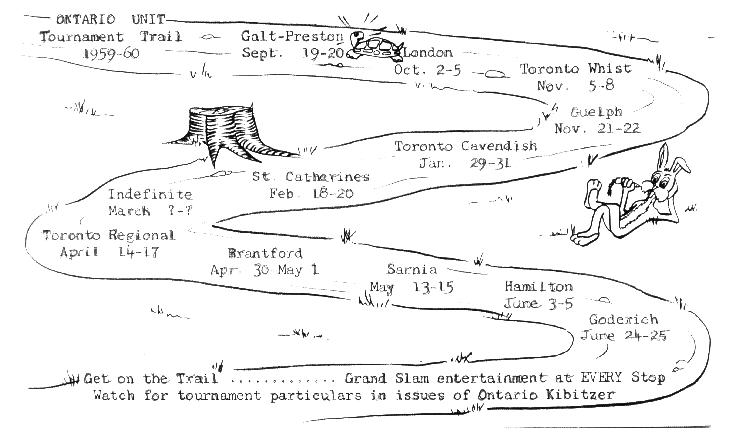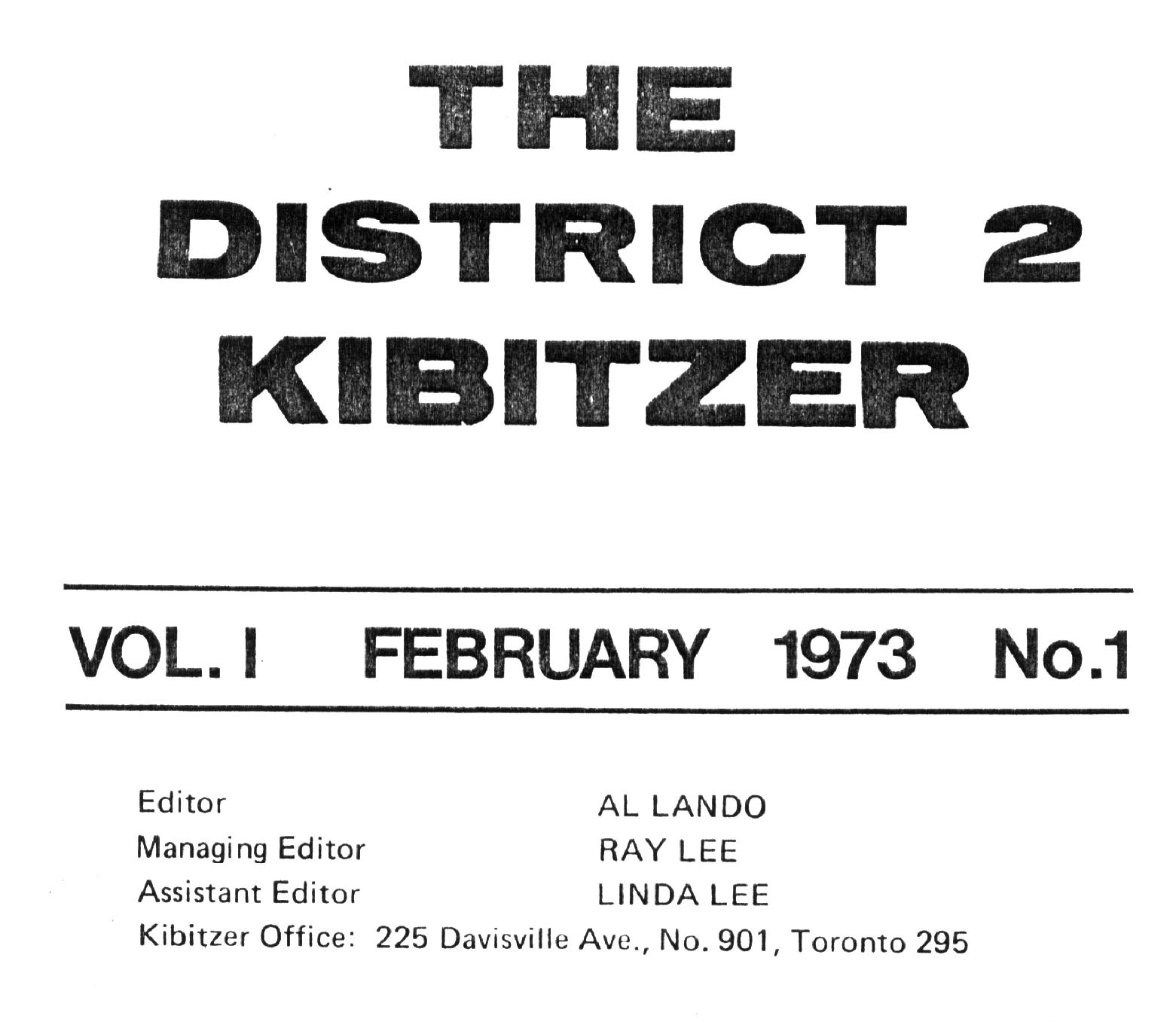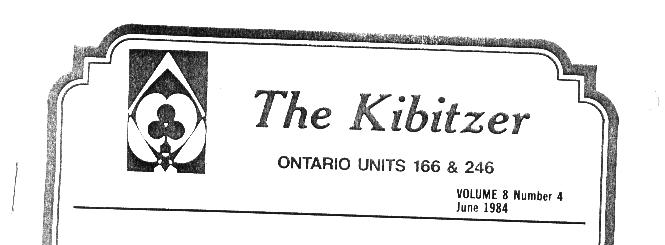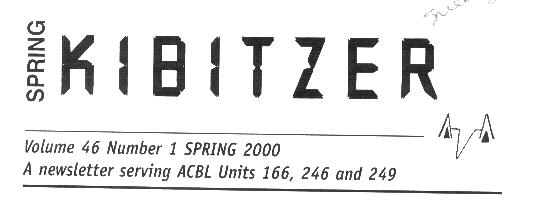
Professionally printed issues were published from 1961 to November 1968, edited by Sammy Kehela. Sammy was a top ranking player of the day who reported on play by local players at tournaments here, in the U.S. and at world competition. Results from local tournaments and the Nationals were published and notices of coming tournaments. The dominant player of the time was clearly Eric Murray. Eric was not only the most successful player but worked tirelessly to improve the game and to raise Canada's status internationally. He and Sam Kehela became world famous players and Sam's descriptions of playing with Eric are humourous and erudite. The pair, together with Percy Sheardown and Bruce Elliott comprised the most successful team this unit had in the 60s. Another famous name crops up again and again in the early editions of the Kibitzer - Kate Buckman. [From the October 1962 issue: "Mrs. Kate Buckman, who has been largely responsible for the surging interest in duplicate bridge in Toronto, scored another success with 'Bridge Week' - six days of various duplicates that attracted a total of 165 tables. Apart from the special games, the 'Week' featured a fashion show, a symposium, and a lecture, and will become an annual event."] Much later the Unit created an annual award for "the person(s) contributing the most to others' enjoyment of bridge". When Kate Buckman received the first award (named for her) she said "Eric should have it! Eric should have it!" In 1992 he did receive it.


A quote from Sam Kehela, December, 1962: "A certain amount of discontent has been voiced in some quarters with respect to the heavy concentration of Toronto news in the Kibitzer. In so far as this is meant to be a Unit undertaking, the criticism is certainly valid. However, and with due respect to the bridge players in the smaller areas, it should be observed that Toronto contains by far the largest and most active bridge population in the province, including some of the most colourful personalities in the game, and that they win roughly 80% of the major events in Ontario tournaments. ... The Kibitzer has become by and large a one-man show. This was not the original intent - in fact, when the publication was launched in its present form two years ago, a request was made for contributions. This elicited a prompt and singular (literally) response in the form of a postal-order for two dollars from some mis-guided well wisher. Apart from the occasional solicited article, I have received only the odd piece, purportedly amusing, that was more in keeping with a high school rag. Though space is limited ... I will be happy to publish any contribution containing technical merit."
After 44 issues and eight years, Sammy retired from editing the Kibitzer. Doug Drew tried it, then Al Lando took over. The publication grew to issues comprising 28-40 pages in length and included photos, articles and tournament news. The July 1971 issue notes that the mailing list for the issue comprises 3,500 members.

Beginning in February 1973 the publication became the "District 2 Kibitzer" to cover play in all units of the newly formed District 2 (Ontario and Manitoba). Ray and Linda Lee assisted Al Lando with the editing for awhile. Some units opposed the district format and did not contribute to the publication, but the general membership in Southern Ontario strongly supported the Kibitzer. However, in August, 1976 publication was suspended. Quote: "The cost of printing and distributing the Kibitzer has outrun available revenues." It was decided that emphasis should be placed on publication of The Digest, a newsletter published by the Canadian Bridge Federation. Editor Lando said, "Over the past 13 years, I have enjoyed my association with the Kibitzer both as a contributor and as editor. ... The readership response over the years has been, generally speaking, pretty good. And an attempt was made to allow the Kibitzer to serve as a forum for the membership. Mostly, Kibitzer readers seem to enjoy reading letters from other members and some of the controversial (sometimes humorous) articles. I've enjoyed the whole thing and wish to thank all those who have taken the trouble to comment on the Kibitzer, favourable or otherwise, as well as those who have contributed material. Any success which the Kibitzer may have had was the result of this type of support."


The first issue of The Kibitzer, as we know it, was published in August 1976 comprising 20 pages of tournament reports, ads, a note from the President of the Unit, a report by John Carruthers from the World Team Olympiad at Monte Carlo, and a Tournament Trail. Robin Wigdor was the Editor and John Howes looked after advertising. Both the Kate Buckman Bridge Studio and the Regal Bridge Studio/St. Clair Bridge Club placed ads.
The August 1977 issue included an insert, named "The Dorbitzer" edited by Ray Lee, which purported to act as junior partner to The Kibitzer. The Kibitzer would confine itself to publishing items about the tournament scene and The Dorbitzer would concentrate on events and people in the Unit. It seems that a "kibitzer" is a senior member of a group of spectators and a "dorbitzer" is any other member of the group. The latter may only speak to players after asking and receiving permission to do so from the kibitzer (p. 9). After five issues John Carruthers took over editing the Dorbitzer part of the publication. Nancy Hart succeeded Robin Wigdor as Kibitzer editor briefly in 1980-81. Beginning in September, 1981 John Carruthers assumed editorship of the Kibitzer and rolled the Dorbitzer part into the main publication.
John Carruthers, another leading player-editor, wrote editorials and attracted excellent, funny and insightful articles from top players of the day. Many were colourful characters with nicknames like The Shoe, The Moo, The Hat, Bungalow, The Owl, Piglet, and Shorty. John also instituted the Kibitzer/Dorbitzer "interviews". The first was, appropriately, with Canada's greatest player, Eric Murray, followed shortly by one with Sam Kehela.
The Kibitzers of the 70s contained a message from the Unit President in each issue, and the November, 1979 issue contained a message from two presidents, The Trent Valley Bridge Association having achieved the status of Unit 246 in that year with approximately 1000 members.

In 1985 the Kibitzer issues were renumbered suddenly to Vol. 31, No. 1. It was reported that this was done because local members had been receving news since at least the fall of 1955 and renumbering would show respect for the previous editors. In actual fact, the earlier publications were quite different and served a different readership than The Kibitzer in its present form. The Fall issue of the 2001 Kibitzer marks the official 25th anniversary of the publication in its current form. A Kibitzer Committee on the Board of Directors was formed in 1985 to determine policy on editorials, advertising, dates of publication and proof reading. The thunderous, insightful editorials and acerbic wit of Sam Kehela and John Carruthers were never to be repeated again. Instead John Armstrong confined himself to his interviews and to printing results, ads, and contributions from members. A "Viewpoint" was published by the Kibitzer Committee for a short while.
The March 1991 issue announced the forming of Unit 249 from the Ontario West Bridge Association. Mary Howe chaired the interim committee. Membership of the new unit that year was 1275.
In the early 90s The Kibitzer began using a computer program which produced mailing labels by household, thus saving printing and mailing costs by not sending out two or three copies to a single family. This system was created by David Bryce, one of our unit's top players and great minds who has been a tournament director, board member, tournament chair, and all-round organizer for many years. He painstakingly manages this database each month and wrestles with the bureaucratic vicissitudes of the ACBL and Canada Post to keep the Kibitzers enroute.
For 16 years John Armstrong edited the Kibitzer. He was a colourful personality of the late twentieth century. His great sense of humour was evident in the Kibitzers where his reference to "the entire staff" who laboured at the "world headquarters" where the "staff member responsible" was castigated for errors or typos evoked a tongue-in-cheek representation of being the editor. In fact, John wrote, layed-out and typeset the publications and handled correspondence himself, not to mention fielding phone calls for information at all hours of the day or night. His e-mail was kibitzer@istar. His car licence plate was KIBTZR. His efforts to travel throughout the province and include news about people and clubs from the entire unit were greatly appreciated. Under his editorship the Kibitzer was recognized and envied throughout the entire bridge playing world.

After 16 years and more than 60 issues John Armstrong retired, and Susan Bracken took over.
This was the year 2000; The Kibitzer at the turn of the century/millennium continued to serve Units 166, 246 and 249 (which had a membership of about 4800).
Susan was an editor in her career. Although she was a Life Master, she regretted not having been able to find the time to 'hone her game'.
Sadly, due to poor health, she had to resign her post in 2003.